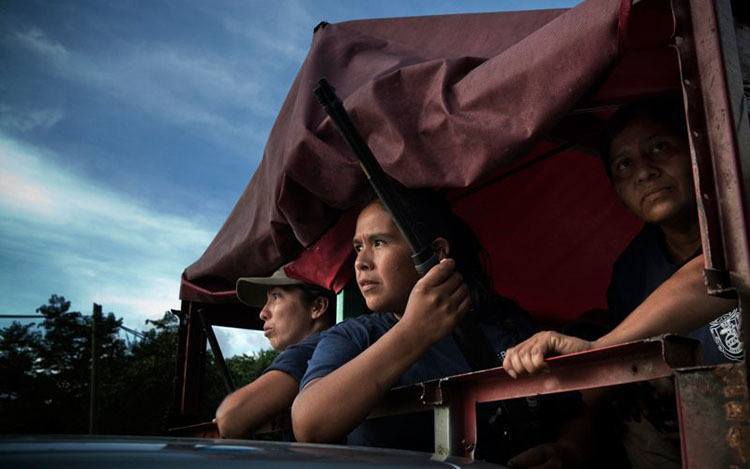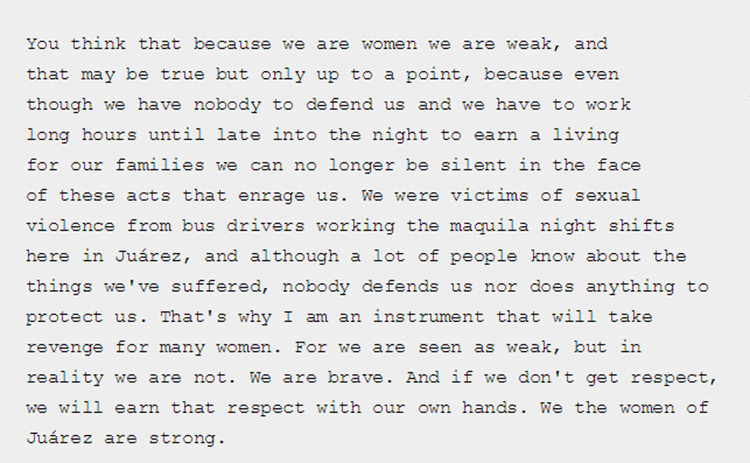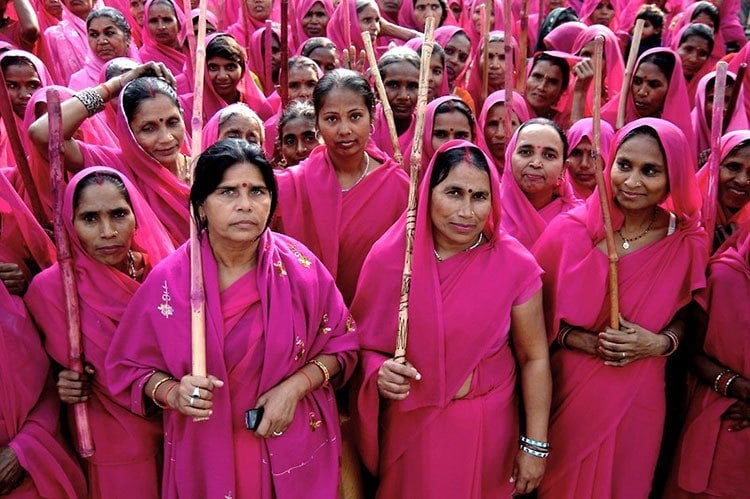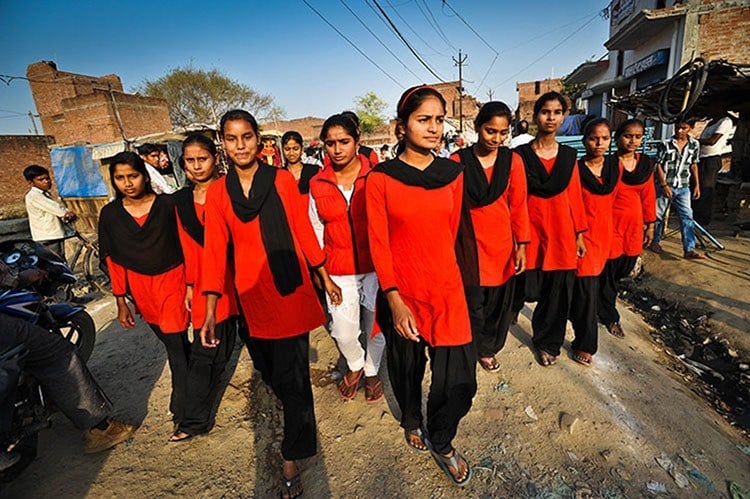When reports of gender-based crimes consistently fall upon deaf ears, at some point, you might just make enact justice for yourself.

A female vigilante group in Xaltianguis, Mexico. Image Source: Katy Orlinsky
It would be an understatement to say that American audiences love the idea of vigilante justice. From the obsidian-cloaked Bruce Wayne to Frank Underwood’s signature House of Cards sneer, contemporary pop culture and media landscapes are inundated with the image of an individual using his own hands to effect his vision of justice.
And that’s just the problem: fiction or not, the protagonists of popular vigilante justice stories are usually men.
When it comes to recent film and television, only The Girl With the Dragon Tattoo and Kill Bill feature female vigilantes as their justice-seeking protagonists. Several other lists of vigilante-themed stories mention women less than five percent of the time.
Those figures don’t exactly reflect reality, though. For better or worse, women have acted as vigilantes throughout history–and in many cases out of necessity.
Around the world, many countries lack adequate laws to protect victims of domestic and sexual violence, which disproportionately affects women. Four out of five victims of sex trafficking are women, one in four women experiences some sort of sexual assault in her lifetime, and forty percent of women who are murdered experience it at the hand of their partners. Often times these acts go unpunished. In some circumstances, women will do the punishing themselves.
For the most part, the stories of women enacting punishment on others have been whispered—not adapted for the silver screen like their male counterparts. Below, we explore some of the women who, moral issues aside, have lived and breathed vigilantism:
Diana the Bus Driver Hunter, Mexico

Image Source: Alice Leora Briggs
Since 2013, Mexico has seen an increase in grassroots movements led by women, sparked by a decades long battle with gruesome femicide, increased presence of drug cartels, and ineffective law enforcement. Many of these women-led vigilante gangs have been successful in removing leaders of drug cartels from their cities, and creating all-female citizen police forces. One vigilante stands out, though: Diana, the Bus Driver Hunter.
Angered by the violence that women had been subjected to on public transit for over two decades, one woman in Ciudad Juárez, otherwise known as the “City of femicide,” decided to take action.
A little over two years ago, a woman who called herself Diana, the Hunter of Bus Drivers donned a blonde wig and avenged the 800 girls and women who had been killed or went missing at the hands of the city’s’ bus drivers. Diana killed two bus drivers and, just after doing so, emailed her reasoning for the murders to a local news source, stating:

Image Source: This American Life
Oscar Maynez, a criminologist who worked on many of these cases explained that local authorities couldn’t be trusted to handle them, stating that the police have done nothing to stop the daily murders occurring in Juárez, whose female homicides are double the rate of the rest of the country. Said Maynez, “First [the police] denied the problem…then they played it down, and finally, they blamed the victims’ lifestyle and their families.”
In 2013, reporter Yuri Herrera, who published Diana’s story on This American Life, attempted to speak to female public transit users in Juárez about the armed vigilante. While many were hesitant to talk to him, insisting they knew nothing about the incident, one young mother remarked, “How great that someone’s doing what many of us should have done.”
The bus driver killer’s identity remains unknown, but her nickname was chosen well. According to Roman mythology, Diana the Hunter is the goddess of women and childbirth, who is known to act out the basic human emotions of rage and revenge.
Nevin Yildirim, Isparta Province, Turkey

Nevin Yildirim Image Source: Onedio
When Nevin Yildrim’s husband left town for seasonal work elsewhere in January 2012, a man named Nurettin Gider began regularly abusing the young mother of two. This abuse included everything from a forced pregnancy and sexual assault to threats that would dishonor her family–which in Turkey, given the rate of honor killings, is a pretty big deal.
Recounting her experience, Yildirim stated,
“Sometimes he would come drunk, take out his gun and have his way. Sometimes I would manage to talk him out and send him away, but resisting was not always possible. Sometimes he would beat me…the rumors were spreading like wildfire in the village. I was ashamed to even go out, spending my days at home alone.”
After eight months of continuous abuse, on August 28, 2012 Yildirim took her revenge.
That night, when Yildirim heard the all too familiar sounds of Gider crawling up the wall of her house, she grabbed her father-in-law’s rifle and shot Gider multiple times until he was dead. She then cut his head off and marched into the village square, where she spoke to men sitting at a coffee shop, saying:
“Don’t talk behind my back, don’t play with my honor. Here is the head of the man who played with my honor.”
Her actions have not gone without repercussion, however. Yildirim is now in jail, serving a life sentence. But her actions have helped spark a discourse about the way Turkey’s judicial system fails battered women.
The Gulabi, India

Members of the Gulabi Gang in India.
All too often, acts of vengeance happen in groups. Northern India is home to one such group which call themselves the Gulabi. Members of the “Pink” Gang operate in one of the poorest and most dangerous districts of India, the Banda District of Uttar Pradesh. In 2013 there were over 1,963 known cases of rape, 7,910 cases of kidnapping, and 2,244 cases of dowry death in the region.
The movement took root in the 1980s, when founder Sampat Devi Pal used a stick against a neighbor who abused his wife. Nine years ago Devi used her brand of alternative justice to start the Gulabi Gang, which now boasts over 400,000 members. Indian journalists have credited the Gulabi members–who can be seen dressed in all pink and wielding bamboo sticks to punish local abusers–for starting a “mini-revolution” on behalf of women.
In an interview with Vice, Sampat Pal details the gang’s process, saying:
“First we go to the police and request that they do something. But since the administration is against the poor people of our country, we often end up taking matters into our own hands. We first speak to the husband who is beating his wife. If he doesn’t understand then we ask his wife to join us while we beat him with lathis [sticks].
Our missions have a 100 percent success rate. We have never failed in bringing justice when it comes to domestic problems. Dealing with the administration is the tricky part since we cannot always take the law in our hands—especially with such corrupt lawmakers. We did beat up some corrupt officials but we were ultimately helpless.”
Beyond helping abused women, the Gulabis also work to prevent child marriages, arrange weddings for couples who are in love despite local protest, and ensure that basic rights for impoverished people are protected.
The Gulabi gang has been such a formidable force over the years that their work has been recognized by local officials. Arvind Sen, the superintendent of the Banda District, notes that their efforts in the area have brought a new desire to fight against women’s exploitation.
The Red Brigade, India

Members of The Red Brigade.
Northern India is also the home of another vigilante group, called the Red Brigade. In 2010, teacher Usha Vishwakarma started the group in Lucknow–one of India’s poorest and most conservative states–after growing tired of the violence against women in her community.
At age 18, Vishwakarma herself was sexually assaulted by a colleague. Though she managed to fight off the aggressor, she was shocked by the fact that nobody seemed to care when she reported the incident, including the police.
Her anger at the way the assault was handled soon turned to action when she held a workshop for her students and learned that 53 out of 55 of her students had experienced some kind of abuse. This abuse ranged from cat calling and lewd comments to sexual assault. To Vishwakarma, this abuse would “threaten to wreck the chances of her young female students,” as concerned parents might make their girls stay home for protection, rather than risk sending them to school. Outraged, she created a core group of fifteen women, ages 15-18, and they learned how to fight for themselves. The group has since expanded to include more than one hundred members.
Adorning themselves in red and black clothing, the girls meet once a month on the anniversary of a particularly brutal New Delhi bus rape. The girls partake in self defense classes, and will discuss topics related to sexual violence against women. Additionally, Red Brigade members will walk around the streets of Lucknow in groups, taunting men who harass women, publicly humiliating them, and sometimes resorting to physical violence. Said Vishwakarma,
“I tell people we don’t want to wait for society to reform, for male attitudes to change, for the police to arrive and act, and for our fathers, brothers and husbands to protect us. Instead we must focus our efforts on making ourselves physically and mentally strong to hit back.”
While the ethics of vigilantism remain up for debate, when reports of gender-based crimes consistently fall upon deaf ears, at some point, you might just make enact justice for yourself. And sometimes, that justice comes in a blonde wig.





